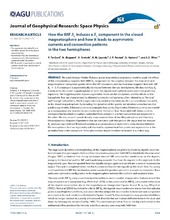How the IMF By induces a By component in the closed magnetosphere and how it leads to asymmetric currents and convection patterns in the two hemispheres
Tenfjord, Paul; Østgaard, Nikolai; Snekvik, Kristian; Laundal, Karl Magnus; Reistad, Jone Peter; Haaland, Stein; Milan, Steve
Peer reviewed, Journal article
Published version

Åpne
Permanent lenke
https://hdl.handle.net/1956/11843Utgivelsesdato
2015-11-12Metadata
Vis full innførselSamlinger
Originalversjon
https://doi.org/10.1002/2015ja021579Sammendrag
We used the Lyon-Fedder-Mobarry global magnetohydrodynamics model to study the effects of the interplanetary magnetic field (IMF) By component on the coupling between the solar wind and magnetosphere-ionosphere system. When the IMF reconnects with the terrestrial magnetic field with IMF By≠0, flux transport is asymmetrically distributed between the two hemispheres. We describe how By is induced in the closed magnetosphere on both the dayside and nightside and present the governing equations. The magnetosphere imposes asymmetric forces on the ionosphere, and the effects on the ionospheric flow are characterized by distorted convection cell patterns, often referred to as “banana” and “orange” cell patterns. The flux asymmetrically added to the lobes results in a nonuniform induced By in the closed magnetosphere. By including the dynamics of the system, we introduce a mechanism that predicts asymmetric Birkeland currents at conjugate foot points. Asymmetric Birkeland currents are created as a consequence of y directed tension contained in the return flow. Associated with these currents, we expect fast localized ionospheric azimuthal flows present in one hemisphere but not necessarily in the other. We also present current density measurements from Active Magnetosphere and Planetary Electrodynamics Response Experiment that are consistent with this picture. We argue that the induced By produces asymmetrical Birkeland currents as a consequence of asymmetric stress balance between the hemispheres. Such an asymmetry will also lead to asymmetrical foot points and asymmetries in the azimuthal flow in the ionosphere. These phenomena should therefore be treated in a unified way.
